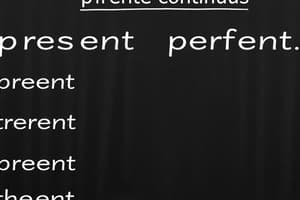Podcast
Questions and Answers
What is the primary use of the present perfect continuous tense?
What is the primary use of the present perfect continuous tense?
- To describe completed actions in the past.
- To express future actions.
- To indicate habitual actions in the past.
- To talk about actions that started in the past and are still happening or connected to now. (correct)
How do you form the present perfect continuous tense?
How do you form the present perfect continuous tense?
- Subject + have + been + verb with -ing. (correct)
- Subject + have/has + verb in the past tense.
- Subject + did + verb in the past participle.
- Subject + will + verb in base form.
Which of the following is a correct negative form of the present perfect continuous tense?
Which of the following is a correct negative form of the present perfect continuous tense?
- I have been not exercising lately.
- I have not been exercising lately. (correct)
- I have not been to the store.
- I been not exercising lately.
Which sentence correctly uses the present perfect continuous tense?
Which sentence correctly uses the present perfect continuous tense?
How do you form a question in the present perfect continuous tense?
How do you form a question in the present perfect continuous tense?
Study Notes
Present Perfect Continuous Tense
- The present perfect continuous tense is used to talk about an action that started in the past and is still happening now, or an action that started in the past and is connected to something that is still happening now.
- Examples: "I've been teaching for over 20 years." "I've been making YouTube videos for over four years."
How to conjugate the present perfect continuous tense
- Conjugate the verb "to have" according to the subject:
- I have
- You have
- He/She has
- We have
- They have
- Add "been" after the conjugated verb "to have."
- Add the verb with an "-ing" ending.
Pronunciation
- In spoken English, "been" is often pronounced as "bin."
- When using the present perfect continuous tense, contractions are commonly used.
Common situations to use the present perfect continuous tense
- When talking about something that started in the past and is still happening now.
- When talking about something that started in the past and regularly keeps happening.
- When using the words "lately" or "recently."
- When providing a reason for a statement.
Using the present perfect continuous in the negative
- Insert "not" between the conjugated verb "to have" and "been."
- Example: "I have not been exercising lately."
Forming questions with the present perfect continuous
- Invert the sentence structure, starting with the verb "to have," followed by the subject, "been," and then the verb with "-ing."
- Example: "Have you been exercising lately?"
Present Perfect Continuous Tense
- Used to describe actions started in the past and continuing into the present
- Indicates an ongoing action or one connected to the present moment
- Examples: "I've been teaching for years", "I've been working on this project all week"
Structure of the Present Perfect Continuous Tense
- Consists of the auxiliary verb "have" (conjugated according to subject) + "been" + verb with "-ing" ending
- Example: "I have been learning" (present tense), "She has been running" (present tense), "We have been sleeping" (present tense)
Pronunciation
- "Been" is often pronounced as "bin" in informal speech
- Contractions are common, e.g., "I've been" instead of "I have been"
Uses of the Present Perfect Continuous Tense
- Talking about ongoing actions: "I've been working on this report since this morning."
- Expressing actions that regularly happen: "I've been going to the gym every week for months."
- Emphasizing duration: "He's been studying for hours."
- Using with adverbs like “lately”, "recently", "for" + period of time, "since" + starting point: "I've been feeling tired lately."
- Explaining a situation: "I'm tired because I've been working long hours."
Using the Negative
- Negative formed by inserting "not" between the conjugated "have" and "been"
- Example: "I have not been studying."
Forming Questions
- Start with the conjugated "have", followed by the subject, "been", and the verb with "-ing"
- Example: "Have you been working on this project?"
Studying That Suits You
Use AI to generate personalized quizzes and flashcards to suit your learning preferences.
Description
Test your understanding of the present perfect continuous tense. This quiz covers its usage, conjugation, and pronunciation tips. Perfect for learners who want to enhance their English grammar skills.




